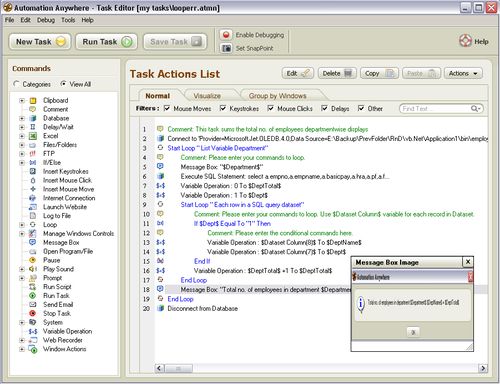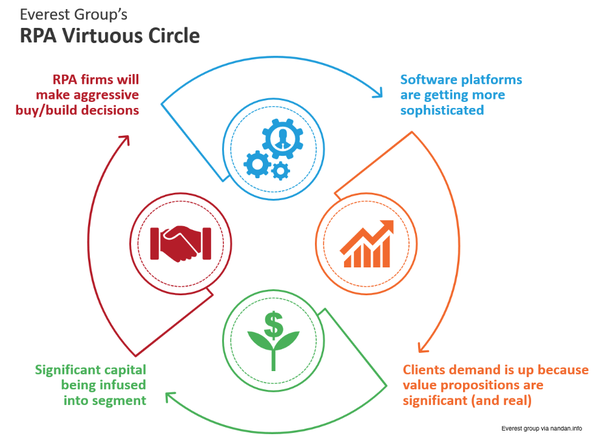When we started a few years back, Robotic Process Automation (RPA) was an emerging technology. We had to explain to people what RPA was. It’s still emerging today however, I can see that lot more people know about RPA (and the hype). But have you thought about the evolution and history of Robotic process automation?
RPA as I see it is a continuation of Computer-based process automation that has evolved over the ages.
Process Automation History
We have gone through multiple waves of process automation since the advent of the Information age.
Computerized Automation (1970 to 90)
In this early phase of the Information revolution, we saw the computerization of lines of businesses in many organizations. This was lead by Management Information Systems or MIS groups within each organization. This phase of process improvement included Quality management (TQM) and continuous process improvement methods. As organizations embraced process-centric approaches to improve business results, they looked to re-engineer and manage the business processes better.
Business Process Management (90+)
Business Process Management (BPM) uses multiple methods to optimize end-to-end business processes. As the Tech companies of the nineties (including IBM, Oracle) came on board this bandwagon, they brought in multiple automation technologies. This technology enabled the automation of business processes and was called Business Process Automation (BPA). BPM continues to be a driving force today and RPA is considered an emerging field within BPA.
Robotic Process Automation (2000+)
RPA emerged in the 2000s – Blue prism released their first product in 2003, UiPath and Automation anywhere released their automation libraries around the same time (all companies were founded a bit earlier).
As per Alastair Bathgate, CEO of Blue prism: “We started focusing on the BPO space as a route to market.. .”. UiPath also started seeing traction for their product with an Indian BPO company. So RPA started off as a way to reduce costs in Business Process Outsourcing and moved to Shared Services, IT Outsourcing, and other Business areas.
Outsourcing reduces expenses by moving lower-level manual tasks and processes to cheaper labor. They were looking at different levers to continue to deliver annual cost savings to their customers. In an effort to continue to reduce costs, RPA started out improving the repetitive processes carried out by these Outsourcing providers.
History of top 3 RPA tools
Robotic Process Automation (RPA) has resulted from the use of multiple technologies to solve business problems. It started by using the humble legacy technologies like screen scraping combined with the Automation workflow software. With the advent of Artificial Intelligence (AI), the cognitive aspects also have started showing up in RPA tools.
Different RPA providers have taken different paths technologically and have evolved into AI unicorns that we see today. All companies have worked with early customers to improve their Digital workforce or bot offerings.
Blue Prism
Blue Prism started off to create an “outsourced workforce” for BPOs.
They claim to have coined the term “robotic process automation”. As per Bathgate, “We were doing robotic process automation before it was called robotic process automation..”
Blue Prism was focused on creating a Digital workforce from the beginning – they were thinking towards solving the problem of doing things an outsourced robot would do including doing the work and scheduling them.
Blue Prism is therefore built around that. They have a Microsoft Visio-like interface to configure the tasks to be performed by the Bot. These Bots can then be deployed and scheduled using an admin console.
Blue Prism is morphing into a technology platform. They have been calling it “Connected RPA”. The aim of the platform is to provide access and foundation for intelligent automation – across multiple industries, companies of all sizes, and across every geography.
Tech Tip: Blue Prism is built on the Microsoft .NET Framework. Blue Prism robot relies on business objects to interact with applications. A business object acts as an adapter to the user interface of specific applications. Blue Prism is one of the few Object-based RPA tools and therefore does not have a recorder.
UiPath
UiPath(then DeskOver) started off by building automation libraries and software development kits. These automation libraries were quite popular and used by companies such as IBM, Google, and Microsoft. These libraries are still embedded in some of their products.
It appears that UiPath then set out to productize these libraries. Initially, their product was not finding much traction. An Indian chapter of a large BPO company that was doing a pilot project to find the best provider of RPA technology choose them. Through this opportunity, they discovered the BPO world and the repetitive work that can be solved through their product – a product-market fit was finally realized.
Around 2012, UiPath (DeskOver) launched the first UiPath Desktop Automation product line that specifically targeted the RPA market. They had just realized the market fit with RPA and started putting its resources into building a platform for training and orchestrating software robots.
Their Platform – the UiPath Enterprise RPA Platform – thus has UiPath Robots which are designed in a UiPath Studio and can be centrally managed from UiPath Orchestrator.
Tech Tip: Uipath is based on Microsoft Workflow Foundation which is again a Microsoft .NET technology meant to create applications that execute an ordered business process. This is a bit of concern as this is probably not on Microsoft’s Azure roadmap.
Automation Anywhere
Automation Anywhere started off as Tethys Solutions and was founded in 2003. The name “Tethys” comes from the Greek goddess of water. Their vision was to make business process automation be as ubiquitous as water. Quite a great vision and they seem to be succeeding to a good extent on that.
Mihir and the team were aiming to replace the scripting applications that were manually done within organizations. Their product, Automation Anywhere allowed for the creation of business process automation designed by the user. They focussed on supporting all aspects of end-to-end business processes.
As per Mihir, they created the product (Automation Anywhere), launched it, and went out for a coffee break. When they came back they were surprised to find that someone from Australia had already bought it!
Automation Anywhere still looks quite like the product they released around 2009! The vision is remarkable. They documented the process and also had a built-in ROI calculator! (edit 2020: The A2019 version has a completely new and revamped look)

Automation Anywhere has also started calling it a platform – “Automation Anywhere Enterprise – The RPA platform for the future of business process automation”. Their core product works like other RPA with a studio to configure workflows and a “Control Center” to deploy and manage the bots. They also have a product called IQ Bot – which is RPA plus AI.
Tech Tip: Automation Anywhere is also built on the Windows .NET framework. You can see that all the top RPA tools are built on Microsoft technologies. This works well because many Enterprises use Windows desktops to do their day-to-day work. RPA works through these Windows interfaces.
Looking ahead – Trends in RPA
RPA is in what Everest is calling a virtuous circle – Real value is leading to more capital which is invested in the tools giving more and more value.

With significant capital being infused, we can see that RPA tools will get better and add more features quickly. Here are a few trends that I see:
Wider Adoption
As I said in the beginning, awareness of RPA has increased multi-fold. More and more enterprises are adopting and implementing RPA. There are challenges to scale through which we shall discuss later.
Added Intelligence
RPA is evolving to include AI. What we can expect to see in the near future from RPA tools include Unstructured data processing, Predictive & Prescriptive Analytics, and simple judgment-based automation.
Process Mining and Discovery
One of the challenges of implementing RPA is that you need to discover, shortlist and prioritize the processes that are ripe for automation. Vendors have been adding this feature and more could follow suit.
Bots as service
It does look like bots would be delivered as cloud services as a natural progression. Most of the RPA tools can work from the cloud even now but is not widely used. There is a possibility that some of the tool vendors would be acquired by Amazon AWS or Microsoft Azure in the future, and be delivered as their service along with their advanced AI capabilities.
Thank you for the well written article.